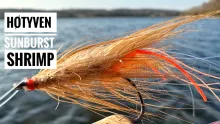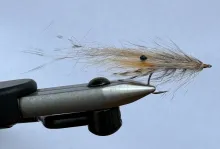The Baltic seatrout community has been going berserk over a huge pink fly called the Pink Pig. I find that the Mini Pig is a more sensible alternative. This article covers two versions.
If you have fished for sea run seatrout in Scandinavia sometime during the last few years, have watched a DVD about the same fishing, have been in a Danish flyshop or read a magazine article about Baltic seatrout fishing, you have most likely seen a large, pink shrimp pattern referred to as Pattegrisen or the Pink Pig. Even we have an article on this large and voluptuous fly.
The same same, just different
My personal relation to the Pink Pig is rather lukewarm. I have never been mesmerized by its virtues and have never been fascinated by it in any way. It's way too large, too complex and too... eh, too pink...
Some people swear by it, and I have heard people refer to increasing average fish sizes when using this fabled fly, which is even sometimes referred to as the "perfect shrimp".
When it appeared on the fly tying scene here in Denmark, it induced an endless demand for pink Whiting Spey hackle, which was already a rare item and soon sold out, which further spawned a completely crazy price increase in this material, essential for tying the Pink Pig.
While all other colors of this in every way nice material were sold for about 35 USD in Danish shops, the "real" pig pinkish (more like a peachish, actually) would set you back close 150 USD! The same same, just different!
Large... and pink...
Danish shrimp are not pink! Well, that's not quite true, because I have a bag of pink shrimp in the freezer. But they are boiled and peeled and ready to lay on a piece of toast and garnished with a squeeze of lemon and a bit of freshly ground pepper.
Real shrimp, live ones like the ones that swim in our ocean and that seatrout eat, are somewhere in the range between a translucent gray and a ditto brownish olive. Far from pink! Some tropical shrimp are indeed pink and very colorful, but in keeping with Scandinavian mentality the Danish shrimp are pretty subdued in color.
I realize that strange colors work, and that many of our flies are far from natural. I oftentimes fish orange flies, and there are no orange animals our waters. But a shrimp should be dull gray, brown or olive in my eyes.
I realize that strange colors work
A small pink alternative
My good fishing friend Ken Bonde Larsen feels the same way as I do about the Pink Pig. He had tied and fished the Pig after its rise to stardom, but found that he had lots of contact but no real takes.
We both had to admit that the Pig produced its fair share of fish, but since he - as I - considered it too large and too complex, he devised a decent alternative. Still pink, still a shrimp, but much smaller and much easier to tie. On its maiden trip it produced him 8 seatrout, which was enough to convince him of its merits.
And you can tie it without the hackle from hell: pink spey hackle.
The Mini Pig
He dubbed the fly with the Danish name Minigrisen or The Mini Pig. I call it Bonde's Mini Pig to tell I apart it from Eskol's Mini Pig, which I will cover below. And that is indeed what it is: a scaled down and simplified version of the larger Pig.
The color can be the same, but is often a slightly more pink than the light peach of the original. The antennae are omitted and the huge rostrum and very fluffy (and very unnatural) legs of the large Pink Pig are replaced by a bit of teal, hackle tips and some teased out dubbing. The body hackle is shorter and lighter. The eyes are the same: black melted and coated nylon eyes.
The aura-technique
Ken uses Gary Borger's aura-technique in the body, sometimes also referred to as Double Magic. We have shown fly patterns using this proven technique before, but for those "late to the party" this is how it's done:
The idea is to get a dubbing "noodle" that has a dense center and a very loose aura. This is obtained by using a dubbing loop and dubbing traditionally on one or both thread legs of the loop, using a dense and short fibered dubbing and maybe wax to get the dubbing to stick. Before the loop is twisted, you insert a much looser and long-fibered dubbing between the legs of the loop and then twist it. What you get is a rope with a lot of loose fibers sticking out as a translucent aura from a tighter rope. These loose fibers will create a halo around the body once the dubbing is wrapped.
If you tease the fibers further with a Velcro stick once the fly is done, you get volume without density as well as a nice transparency, which is much like a natural shrimp. At the same time a body dubbed in this way is very robust thanks to the strong, central dubbing rope.
The natural version
It is a very obvious choice to make a natural (read: non-pink!) variation of this fly, and by using light gray or light olive dubbing and a grizzly hackle you get very close to a natural shrimp.
Our experience tells us that the pink version IS a real producer, but personally I do prefer more naturally colored alternatives.
Eskol's Mini Pig
Another very good fishing friend - Henning Eskol - has even simplified the fly further, omitting the aura technique and the hackle.
Henning's fly consists of a mallard and pink hackle "tail", a simple dubbed body and large, black monofilament eyes. It can be tied in a minute, and is both very durable and hassle free to tie and to use. As with Bonde's Mini Pig it can be tied in dull colors if you want a fly that's closer to the natural. Henning swears by the pink version and half his flybox is this pattern only.
Fishing shrimp flies
There isn't much hocus-pocus to fishing shrimp flies. In most instances they can be fished like any other fly: cast it out over a likely holding spot for the fish, let it sink a bit and strip it back in foot-long strips.
Natural shrimp have a very abrupt and jerky pattern of motion, which is hard to imitate, but some really fierce tucks now and then followed by a long break where the shrimp sinks can be really good. When fish strike, they are likely to hit the fly at the first motion after the fly has been sinking and maybe even has dropped all the way to the bottom.
For a natural motion I urge you to use a loop knot for attaching the shrimp pattern to the tippet. This will let the small fly move in a much more natural manner.
Replacing the Spey hackle
The Spey hackle is as already mentioned its weight worth in gold, and although it's an excellent material it is expensive and can be hard to find - especially in the peach/pink color used for these flies.
Consider some alternatives.
Whiting's Chickabou has many of the same traits as the Spey hackle. Not quite as long or quite as fluffy, but if you go through a batch they are not all created equally, and you can often find some that are very close to the Spey. And the price is much kinder to the wallet! I bought several a few months back and paid only 75 DKK or less than 14 USD a piece! I went through a whole bunch and got some that are very close to the Spey hackle - even a pink one!
You can also look for so called Bird Fur, which comes from several hackle farms. It's much like the Spey Hackle, but typically in smaller skins with smaller feathers, which will be fine for these flies.
Another alternative is plain marabou, which is widely available in all kinds of colors and inexpensive too. Most of it is very fluffy, but some feathers in a package are more like hackle feathers, and can replace the Spey hackle.
Last but not least large saddles often have some feathers that are useful for this kind of application. You can cut some barbs from the largest base feathers and brush them with a toothbrush and get an effect that is almost close to the Spey hackle - and at least available and cheap.
Tying instructions for Eskol's Mini Pig
|
|
|
|
|
|
|
|
|
|
|
|
|
|
|
|
|
|
|
|
|
|
|
|
|
|
|
|
|
|
|
|
|
|
|
|
|
|
|
|
|
|
|
|
|
|
|
|
|
|
|
|
- Log in to post comments



























































A friend of mine use
A friend of mine uses Craft fur placed into the loop instead of spey feathers. Then the fly is brushed by comb and the fly looks very similar to the spey original and it is more durable. And the craft fur costs only 6 or 7 USD.